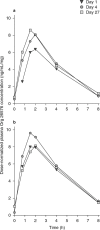Maximum tolerated dose evaluation of the AMPA modulator Org 26576 in healthy volunteers and depressed patients: a summary and method analysis of bridging research in support of phase II dose selection
- PMID: 22852579
- PMCID: PMC3585695
- DOI: 10.2165/11634360-000000000-00000
Maximum tolerated dose evaluation of the AMPA modulator Org 26576 in healthy volunteers and depressed patients: a summary and method analysis of bridging research in support of phase II dose selection
Abstract
Background: A key challenge to dose selection in early central nervous system (CNS) clinical drug development is that patient tolerability profiles often differ from those of healthy volunteers (HVs), yet HVs are the modal population for determining doses to be investigated in phase II trials. Without clear tolerability data from the target patient population, first efficacy trials may include doses that are either too high or too low, creating undue risk for study participants and the development program overall. Bridging trials address this challenge by carefully investigating safety and tolerability in the target population prior to full-scale proof-of-concept trials.
Objective: Org 26576 is an alpha-amino-3-hydroxy-5-methylisoxazole-4-propionic acid (AMPA) receptor positive allosteric modulator that acts by modulating ionotropic AMPA-type glutamate receptors to enhance glutamatergic neurotransmission. In preparation for phase II efficacy trials in major depressive disorder (MDD), two separate phase I trials were conducted to evaluate safety, tolerability, and pharmacokinetics in HVs and in the target patient population.
Methods: Both trials were randomized and placebo controlled, and included multiple rising-dose cohorts (HV range 100-400 mg bid; MDD range 100-600 mg bid). HVs (n = 36) and patients with MDD (n = 54) were dosed under similarly controlled conditions in an inpatient facility, HVs for up to 14 days and MDD patients for up to 28 days. Safety, tolerability, and pharmacokinetics were assessed frequently.
Results: Despite comparable pharmacokinetic profiles, the maximum tolerated dose (MTD) in depressed patients was 450 mg bid, twice the MTD established in HVs. No clinically relevant safety issues associated with Org 26576 were noted.
Conclusion: This article presents safety, tolerability, and pharmacokinetic data from two different populations examined under similar dosing conditions. The important implications of such bridging work in phase II dose selection are discussed, as are study design and data interpretation challenges.
Figures






References
-
- Cutler N.R., Sramek J.J., Murphy M.F., et al. Critical pathways to success in CNS drug development. 1st. Oxford: Wiley-Blackwell; 2010.
-
- Sramek J.J., Cutler N.R. Investigator perspective on MTD: practical application of an MTD definition — has it accelerated development? J Clin Pharmacol. 2000;40:1184–7. - PubMed
-
- Ereshefsky L, Jhee S, Gertsik L, et al. Strategies to accelerate drug development for CNS compounds: focus on schizophrenia [poster]. 15th Biennial Winter Workshop in Psychoses; 2009 Nov 15–18; Barcelona
-
- Vanover K, Davis R, Ereshefsky L, et al. Safety, pharmacokinetics and early signals for efficacy of ITI-007, a novel investigational drug for the treatment of schizophrenia and related disorders [poster]. 13th International Congress on Schizophrenia Research; 2011 Apr 2–6; Colorado Springs (CO)
Publication types
MeSH terms
Substances
LinkOut - more resources
Full Text Sources
Medical

